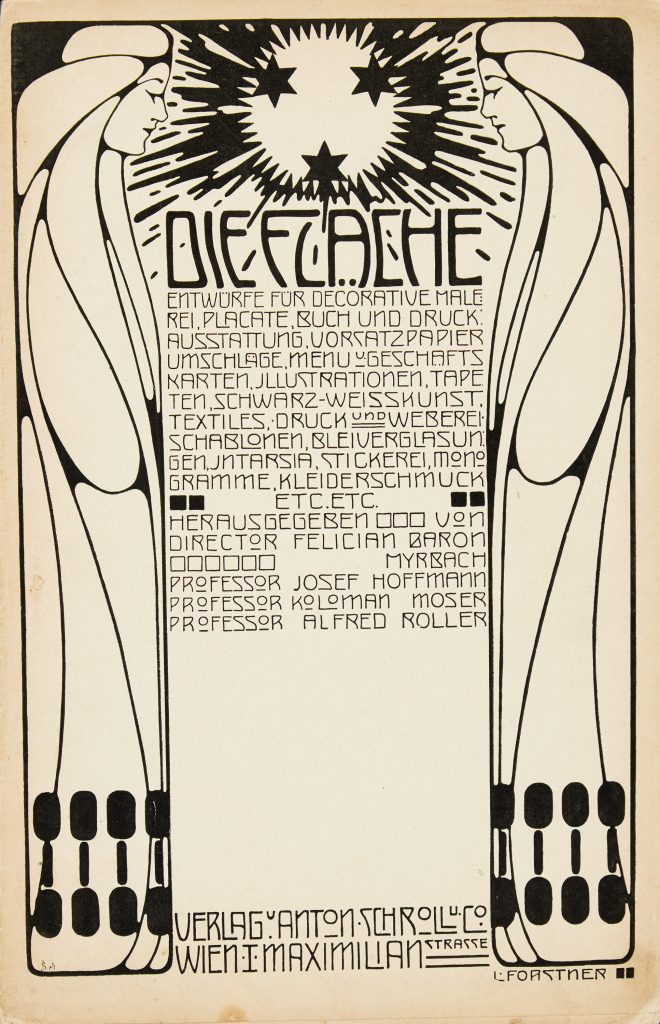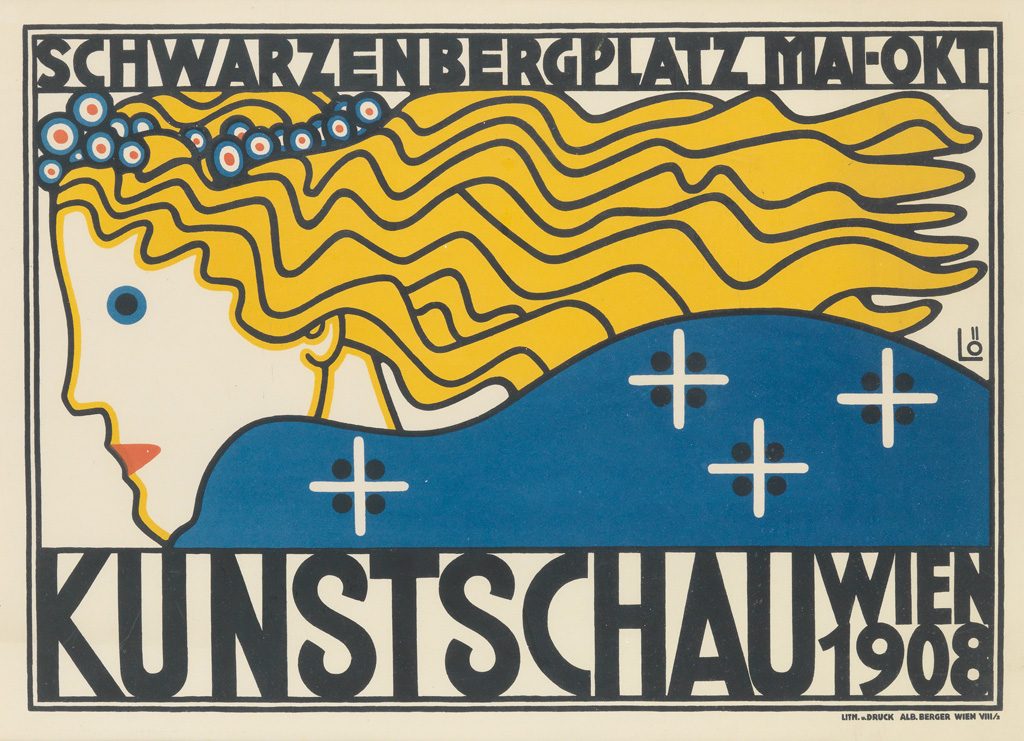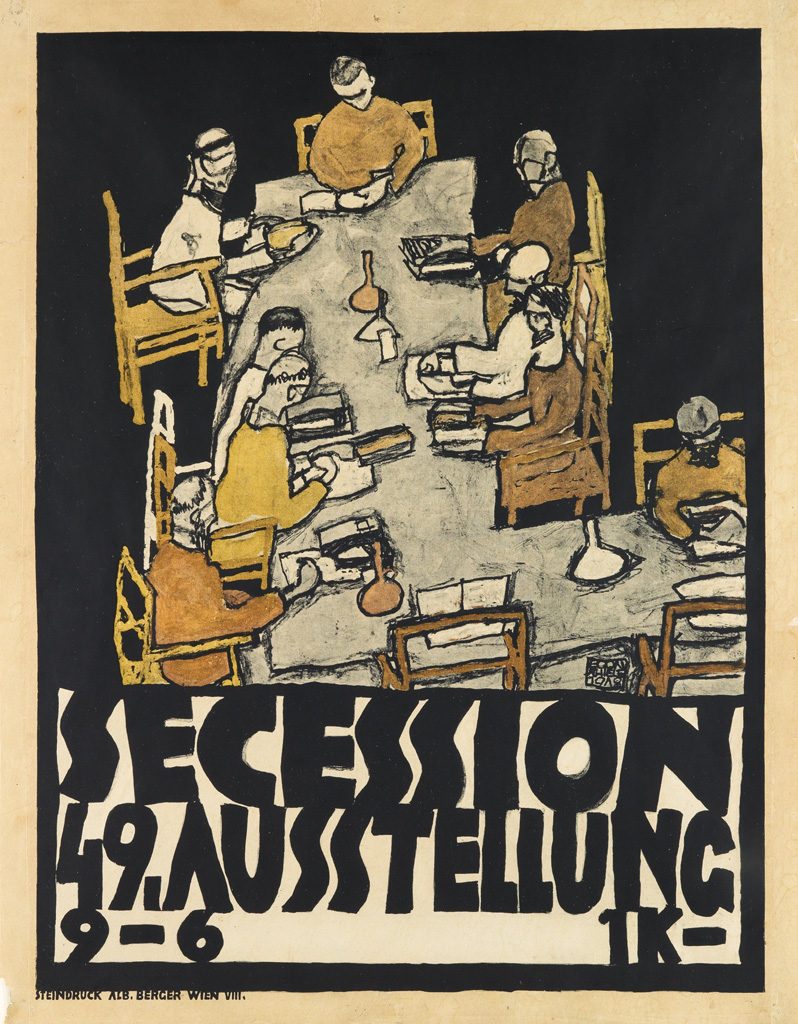This post includes notes from the catalogue of our May 25 auction of Graphic Design, featuring an extensive selection of works out of the Wiener Werkstätte, the design school for the Vienna Secession.

Lot 10: Emil Rudolph Weiss, Die – Insel, 1899. Estimate $2,000 to $3,000.
Unlike some artistic movements whose names came from outside the artists involved, such as the Impressionists or the Fauves, the Vienna Secession was the concerted effort of a group of artists, led by Gustav Klimt, to create a new standard for design. In 1903, the participants formed a school called the Wiener Werkstätte in order to spread their ideas. A palatial building was designed in 1897 by Joseph Maria Olbrich, where the group held a series of exhibitions to expose the public to their new ideas and styles. In gold lettering above the entrance reads the phrase, Der Zeit ihre Kunst. Der Kunst ihre Freiheit. (To every age its art. To art its freedom.)

The entrance to the Secession building, Vienna. Creative Commons.
The movement was also called Jugendstil (“The Young Style”) because members sought to break away completely from any established art historical tradition. Like its parent movement, Art Nouveau, the Vienna Secession was a reaction against the conservative art traditions that dominated Germany and Austria at the time.

Lot 1: Die Fläche, complete volume on 192 illustrated pages, 1903-04. Estimate $12,000 to $18,000.
Die Fläche (The Surface) was the design magazine published by the Wiener Werkstätte. Leopold Forstner‘s illustrated cover explains the contents: “Designs for decorative painting, posters, book and printing equipment, preprinted, envelope, menu and business cards, illustrations, wallpapers, black and white art, textile, weaving and printing, stencils, lead glazings, intarsia, embroidery, monograms, dress jewelry etc etc.”
The publication reproduced works by such masters as Josef Maria Auchentaller, Gustav Klimt, Koloman Moser, and Alfred Roller, as well as other prominent Viennese artists.

Lot 2: Ottokar Mascha, Österreichische Plakatkunst, circa 1914.
Estimate $6,000 to $9,000.
Österreichische Plakatkunst is the only comprehensive book on the Austrian poster during its golden age. It contains works by Ernst Deutsch, Klimt, Julius Klinger, Moser and Egon Schiele, among others. Very few copies survive, as it was probably published in 1914, and suffered from appearing right at the beginning of the First World War. In many ways it can be considered the Maîtres de l’Affiche of the Austro-Hungarian Empire, with the addition of scholarly text to complement the images.

Lot 3: Koloman Moser, Richardsquelle, 1899. Estimate $12,000 to $18,000.
Koloman Moser was a founding member of the Vienna Secession and a professor at Vienna’s School of Arts and Crafts. Together with Josef Hoffmann, he co-founded the Weiner Werkstätte and was a versatile and prolific artist in his own right. Book design, graphic design, interior design, jewelry, furniture, silverware, fashion and ceramics were just some of the fields in which he excelled. Much of his graphic work was done on behalf of the Secession and his commercial posters are quite rare. Here, he advertises mineral water from the Bohemian spa town of Lazne Kynzvart (Bad Königswart, in German). Richardsquelle, the name of the spring, was named after Prince Metternich’s son Richard. The first printing of several variations, this poster was issued again around 1908, including the image of the bottle itself.

Lot 5: Bertold Löffler, Kunstschau Wien, 1908. Estimate $30,000 to $40,000.
Bertold Löffler studied at the School of Arts and Crafts alongside Moser. Much of his graphic work was produced for the Kabarett Fledermaus and the Wiener Werkstätte, for whom he designed posters, postcards, calendars and other collateral material. In 1908, Löffler participated in the art exhibition, Kunstschau. Organized by Klimt, the large exhibition combined the work of Vienna’s School of Arts and Crafts, the Art School for Women and Girls and the Wiener Werkstätte. The poster Löffler designed to promote the exhibition is a masterful stepping stone between the heavy, often abstract ornamentation of the Secession and the cleaner, more linear designs of the Wiener Werkstätte.

Lot 7: Egon Schiele, Secession 49: Ausstellung, 1918. Estimate $15,000 to $20,000.
Egon Schiele was one of the meteoric talents of the Secession movement. Unlike the colorful and decorative work of the early Secessionists, Schiele’s output was darker and more intense, highlighted by powerful, erotic and figurative imagery. He can rightfully be considered one of the first Expressionists. As part of the Secession’s 49th Exhibition, Schiele was granted an entire room to display the 50 of his works that had been chosen. He also designed the exhibition poster itself. He imagined all the participants of the Secession gathered around a dinner table, with himself at the head. The empty seat opposite him is said to be intended for Gustav Klimt, who died about a month before the exhibition’s opening. The exhibition launched Schiele into international renown. Tragically, Schiele died during the Spanish Flu pandemic later that year.
For more design from the Viennese Secession, browse the full catalogue.
The post Graphic Design in the Vienna Secession appeared first on Swann Galleries News.